|
65. Polyommatus thersites (Cantener, 1834) / Chapman's blue / Lycaenidae – Polyommatinae
NL: esparcetteblauwtje / D: Kleiner Esparcettenbläuling, Esparcetten-Blaüling / F: azuré de l’esparcette, l’argus bleu roi
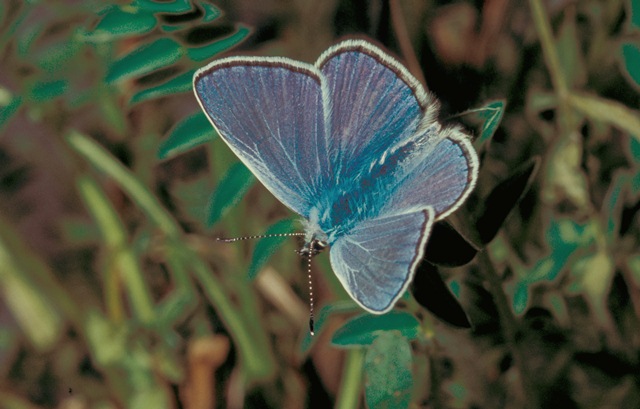  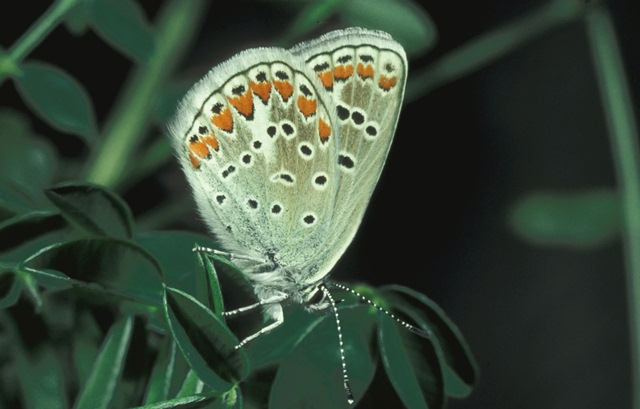
Photographs: Frits Bink ©.
Small or very small, wing length spring generation, 15 (14-16) mm, in summer 13 (12-14) mm. In the Benelux, it occurred in a few places on unimproved grassland where sainfoin grew. The last records are from 1950.
The butterfly is on the wing from mid-May until end-August and peaks end-May and mid-August. It is known from maritime and mild continental climates, amplitude 7 to 16. Required heat sum 800°d and maximum tolerated 2300°d, corresponding climate windows are 25 and 41 weeks.
Not far from the Belgium border, on Cap Blanc Nez, France, there are fields with sainfoin situated in the lea of the hills where the species occurs. In southern Europe it occurs also on arable fields with sainfoin.
Ecological characteristics
Behaviour over time
Overwintering: small larva in second or third instar in litter layer.
Reproduction: oviposition starts after 6-8 days when the body contains 63 (47-66) eggs, estimated production 2.2 times as much.
Larval feeding periods: summer brood 34 (26-40) days from early-June until late-July, overwintering generation 17 (9-27) days in the autumn and next spring 45 (35-55) days from early-April until mid-May.
Generations: two or three.
Spreading of risk: flexibility in diapause.
Life cycle: egg 7 (6-9) days; larva summer brood 5 weeks, overwintering generation 28 weeks; pupa 14 (11-27) days.
Life span of adult: rather long, 3 weeks.
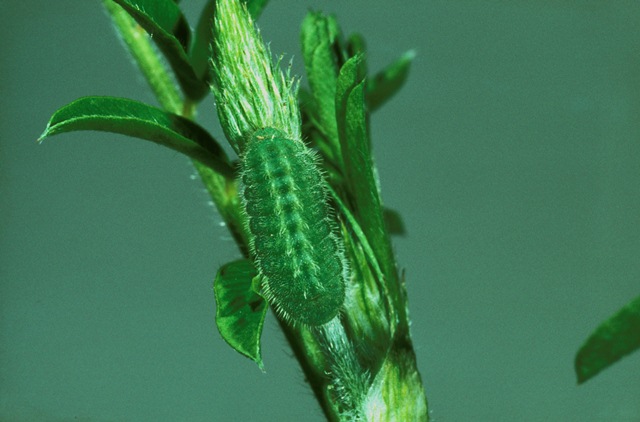 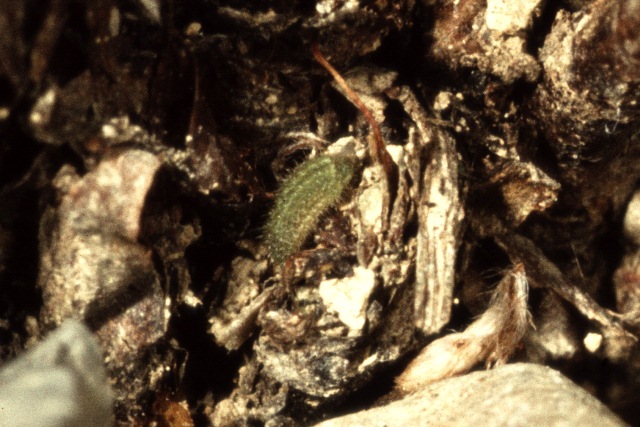
Photographs: Frits Bink ©.
Behaviour in space
From stay-at-home to migrant: stay-at-home, spatial requirement very modest.
Finding a mate: male perches and patrols.
Orientation in the landscape: warm and sheltered sites with tall grassland, also on arable fields with sainfoin.
Oviposition: on upperside of the leaf or on the stem near the shoot.
Defence
Threats from other organisms: no defence, larvae are cryptic coloured on the host-plant.
Myrmecophily: full array of ant-attracting and appeasing organs present but larvae are little attended by ants.
Threats from the environment: larvae and adults endure heat and drought quite well.
Feeding habits
Adult: nectar, all kinds of flowers.
Larva: very small larvae mines, as they grow they prefer shoots and flower buds.
Larval foodplants
Plant species: Fabaceae, Onobrychis viciifolia.
Journal
Rearing experiment based on specimens from Aurel, Vaucluse, France:
29 August 1984: butterflies collected from field of sainfoin.
30 August to 1 September: eggs laid.
9 September: eggs hatched.
18 September: first instar larvae on the leaves, one brown second instar hidden between auricles.
26 September: second instar larvae on the leaves, they were brown-green in colour and clearly different from those of P. icarus.
6 October: larvae which will overwinter separated from those which will develop to pupal stage.
16 October: six larvae fully grown, those larvae which had entered diapause were either in L2 or L3.
20 October: first pupa, prepupae in a cluster together, no sign of cannibalism, larvae did not spin girdles like P. icarus but lay on the ground in the litter.
6 November: first adult appeared.
8 November: other pupae hatched.
17November: pupae of slower growers hatched.
Those larvae in diapause, overwintered in fridge.
14 March 1985: larvae taken out of the fridge, there was no Onobrychis available, tried Hippocrepis comosa.
22 March: 3 larvae were put on a few leaves of a poorly growing Onobrychis, ate it immediately.
6 April: 3 biggest larvae alive, one became cannibalistic.
10 April: larvae placed on Astragalus.
15 April: Astragalus not accepted, larvae dead.
20 May: one adult appeared, unclear as to what food source the larva had used.
Table 65-1. Results of dissections

Table 65-2. Collection and observation localities
F, Aurel, 400 m, 44° 43’N – 5° 16’E; 29 August 1984, 2 September 1984.
F, Cap Blanc-Nez, 30 m, 50° 55’ 37”N – 1° 42’ 45”E; 10 June 2000.
F, Lorraine, Jaulny, 209 m, 48° 57’ 55”N – 5° 52’ 52”E; 29 June 2002, 8 July 2006.
F, la Motte Chalançon 44° 28’ 40”N – 5° 22’ 23”E; 8 September 1982.
Fig. 65-1. Polyommatus thersites, phenogram adapted from Ebert & Rennwald 1991b: 382.
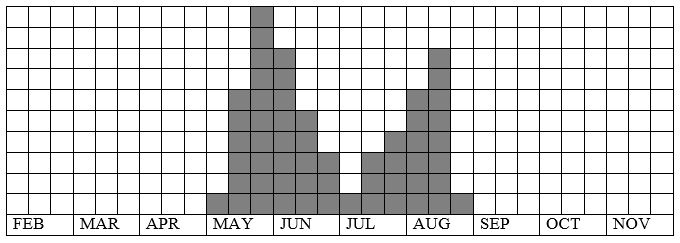
Fig. 65-2. Polyommatus thersites, habitat characteristics.
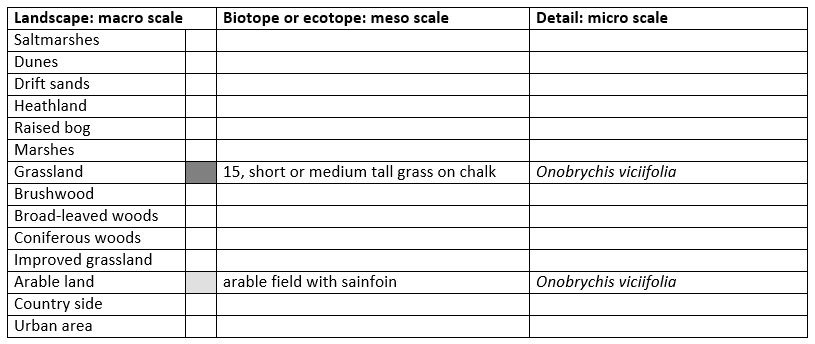
Fig. 65-3. Polyommatus thersites, climate matrix, heat-sums 800 - 2300°d.
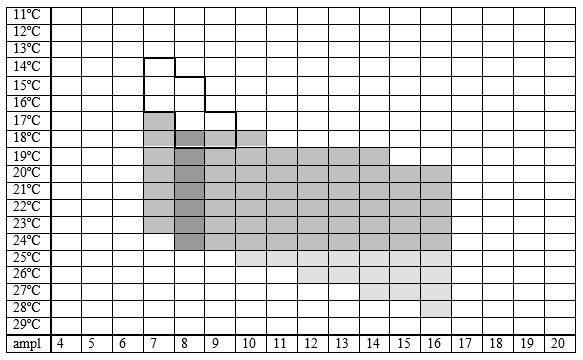
|










